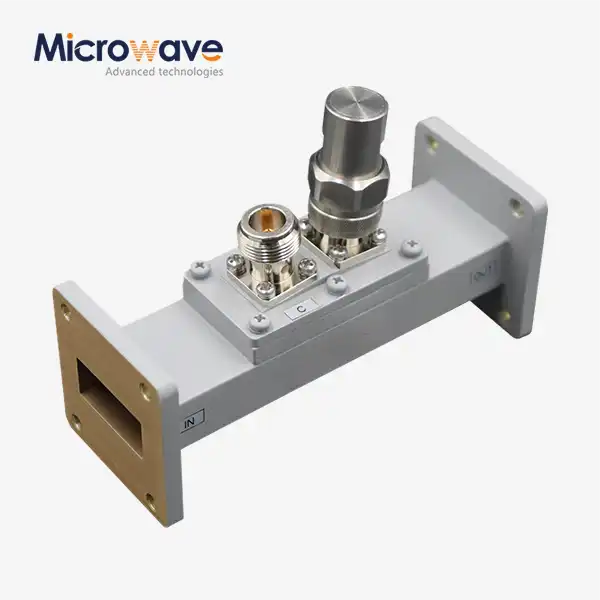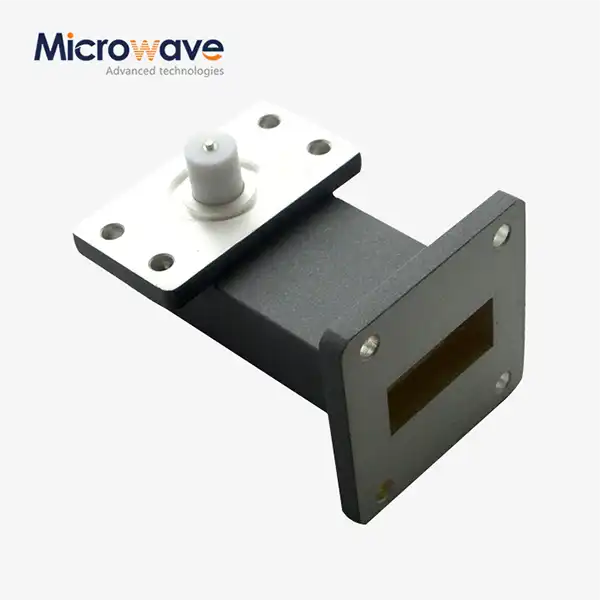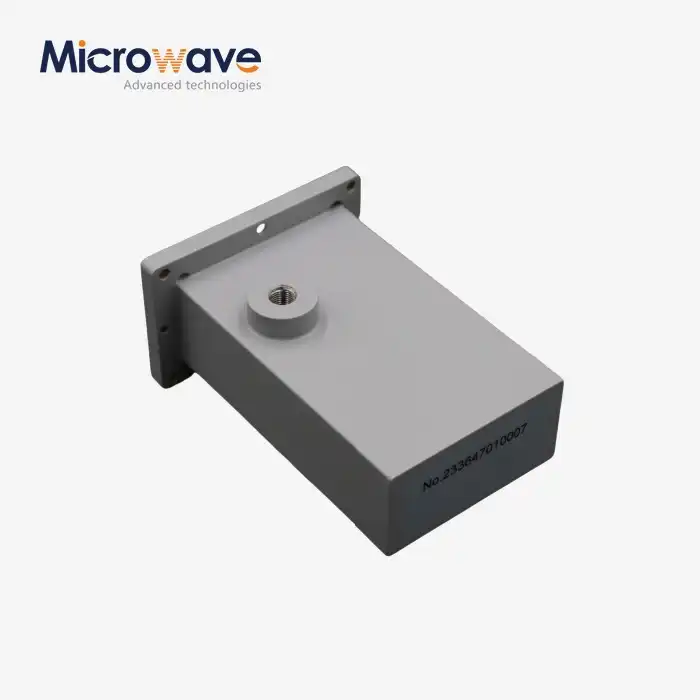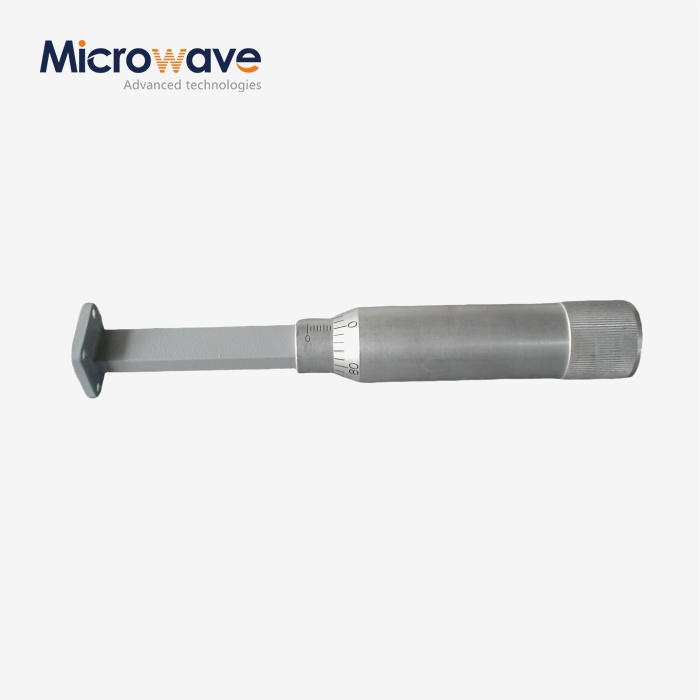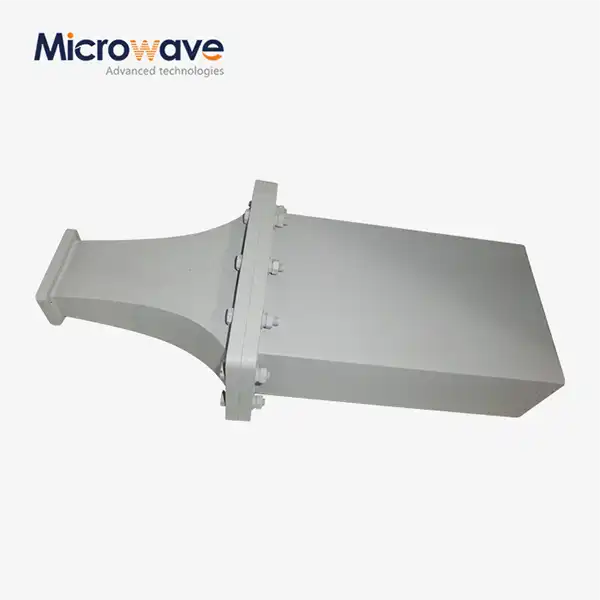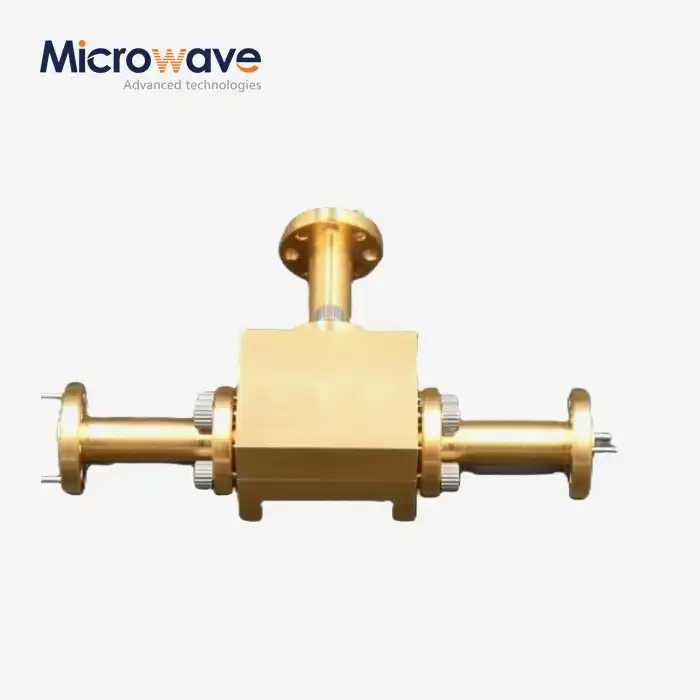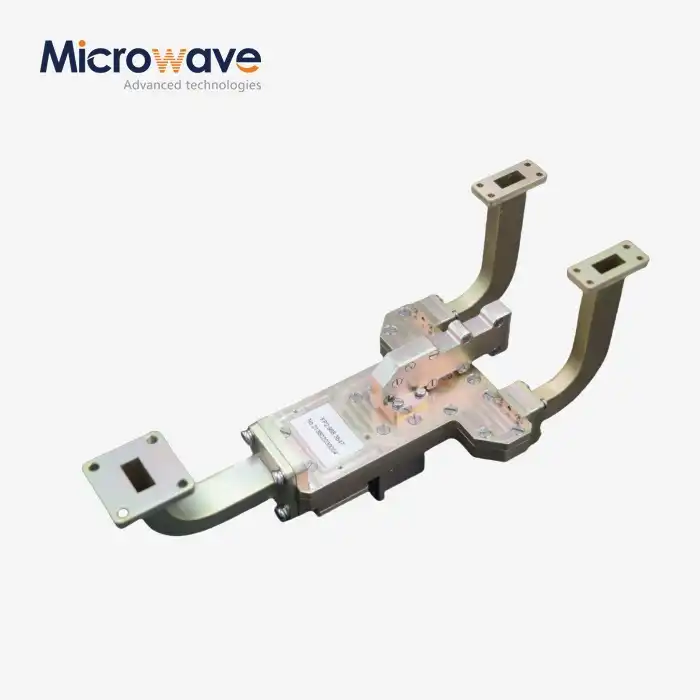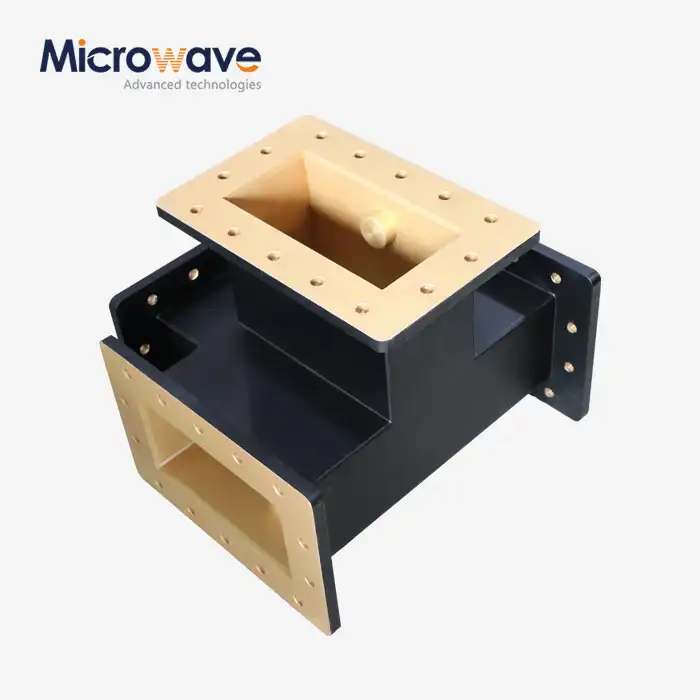How Does a Right Angle Waveguide to Microstrip Adapter Improve Signal Efficiency at High Frequencies?
In the rapidly evolving world of microwave technology, the seamless integration of different transmission line technologies is crucial for optimal system performance. At the heart of this integration lies the Right Angle Waveguide to Microstrip Adapter, a sophisticated component that bridges the gap between waveguide and microstrip transmission systems. This adapter represents a critical solution for engineers seeking to maintain signal integrity while transitioning between different transmission mediums at high frequencies. The Right Angle Waveguide to Microstrip Adapter fundamentally improves signal efficiency through its precision-engineered design that minimizes impedance mismatches and reduces reflection losses at the transition point. By maintaining consistent characteristic impedance across the transition, this adapter ensures that electromagnetic energy transfers smoothly from the waveguide structure to the microstrip line without significant power loss or signal degradation. The right-angle configuration not only saves valuable space in compact systems but also provides mechanical advantages in system assembly while preserving the electrical performance characteristics essential for high-frequency applications.
Understanding the Fundamental Mechanisms of Signal Efficiency Enhancement
Impedance Matching Principles in High-Frequency Applications
The primary mechanism by which a Right Angle Waveguide to Microstrip Adapter improves signal efficiency lies in its sophisticated impedance matching capabilities. At high frequencies, impedance mismatches between different transmission line types can cause significant signal reflections, leading to power loss and degraded system performance. The Right Angle Waveguide to Microstrip Adapter addresses this challenge through careful geometric design that creates a smooth impedance transition between the waveguide's characteristic impedance and the microstrip line's 50-ohm or 75-ohm impedance. This transition is achieved through a tapered or stepped impedance structure that gradually transforms the electromagnetic field configuration from the waveguide mode to the microstrip mode. Advanced Microwave Technologies Co., Ltd. leverages over 20 years of experience in microwave product development to engineer these adapters with precision-controlled dimensions that maintain impedance continuity across the entire frequency range from 10 GHz to 110 GHz. The adapter's internal structure incorporates sophisticated electromagnetic modeling to ensure that the field patterns are properly transformed without creating unwanted modes or resonances that could degrade signal quality.
Electromagnetic Field Transformation and Mode Conversion
The effectiveness of a Right Angle Waveguide to Microstrip Adapter in improving signal efficiency depends heavily on its ability to manage electromagnetic field transformation during the transition process. Waveguides support transverse electric (TE) and transverse magnetic (TM) modes, while microstrip lines primarily support quasi-transverse electromagnetic (quasi-TEM) modes. The Right Angle Waveguide to Microstrip Adapter must facilitate this mode conversion while minimizing energy loss and maintaining signal integrity. The adapter accomplishes this through carefully designed transition regions that gradually reshape the electromagnetic field patterns. Advanced Microwave's expertise in antenna measurement systems and their 24m Microwave Darkroom facility enables them to precisely characterize and optimize these field transformation processes. The adapter's design incorporates specialized geometric features such as probe coupling mechanisms, slot coupling, or ridge-loaded transitions that ensure efficient energy transfer between the different transmission modes. These mechanisms are particularly crucial at millimeter-wave frequencies where even small dimensional tolerances can significantly impact performance.
Minimizing Reflection Losses Through Optimized Geometry
Reflection losses represent one of the most significant challenges in high-frequency signal transmission, and the Right Angle Waveguide to Microstrip Adapter addresses this through optimized geometric design. The adapter's internal structure features carefully calculated dimensions that create a gradual impedance transformation, preventing sudden changes that would cause signal reflections. Advanced Microwave Technologies Co., Ltd. employs sophisticated electromagnetic simulation tools and validates their designs using their comprehensive measurement facilities equipped with equipment capable of operating up to 110 GHz. The Right Angle Waveguide to Microstrip Adapter incorporates features such as matching posts, iris structures, or stepped transitions that fine-tune the impedance matching across the desired frequency range. These design elements work together to maintain return losses below specified thresholds, typically better than -20 dB, ensuring that the majority of the input signal power is successfully transferred to the output rather than being reflected back to the source. The adapter's construction materials and manufacturing tolerances are carefully controlled to maintain these performance characteristics across temperature variations and mechanical stress conditions.
Technical Design Features That Maximize Performance
Advanced Materials and Construction Techniques
The performance of a Right Angle Waveguide to Microstrip Adapter is fundamentally dependent on the materials and construction techniques employed in its manufacture. Advanced Microwave Technologies Co., Ltd. utilizes high-grade materials that maintain stable electrical properties across the entire operational frequency range and environmental conditions. The Right Angle Waveguide to Microstrip Adapter typically incorporates low-loss dielectric materials with precisely controlled dielectric constants and loss tangents to minimize signal attenuation. The metallic components are manufactured from high-conductivity materials such as copper or silver-plated brass, which provide excellent electrical conductivity while maintaining mechanical stability. The manufacturing process involves precision machining techniques that achieve dimensional tolerances within micrometers, ensuring consistent performance across production batches. Surface treatments and plating processes are carefully controlled to minimize surface roughness, which becomes increasingly important at millimeter-wave frequencies where skin depth effects can significantly impact conductor losses. The adapter's construction also incorporates environmental protection features such as corrosion-resistant coatings and hermetic sealing options for applications requiring operation in harsh environments.
Frequency Response Optimization and Bandwidth Considerations
The Right Angle Waveguide to Microstrip Adapter's ability to maintain consistent performance across wide frequency ranges is a critical factor in its effectiveness for high-frequency applications. Advanced Microwave's design approach focuses on creating broadband matching networks that provide excellent performance across the entire specified frequency range, typically spanning multiple octaves. The adapter's internal matching network is designed using advanced filter synthesis techniques that create multiple resonant modes to flatten the frequency response and minimize insertion loss variations. This approach ensures that the Right Angle Waveguide to Microstrip Adapter maintains consistent impedance matching and low insertion loss across the entire operating bandwidth. The frequency response optimization also considers group delay characteristics, ensuring that the adapter does not introduce significant phase distortion that could affect signal quality in communication systems. Advanced Microwave's extensive measurement capabilities, including their Antenna Plane Near and Far Field Measuring Recombination Chamber, enable comprehensive characterization of the adapter's frequency response under various operating conditions. The design process incorporates sensitivity analysis to ensure that manufacturing tolerances do not significantly impact the frequency response characteristics.
Mechanical Design for Reliability and Ease of Integration
The mechanical design of the Right Angle Waveguide to Microstrip Adapter plays a crucial role in both its electrical performance and practical implementation in microwave systems. The right-angle configuration provides significant advantages in space-constrained applications while maintaining the electrical performance characteristics required for high-frequency operation. Advanced Microwave Technologies Co., Ltd. designs these adapters with robust mechanical structures that can withstand the mechanical stresses associated with system assembly and operation. The Right Angle Waveguide to Microstrip Adapter incorporates precision-machined connection interfaces that ensure repeatable electrical performance across multiple connect/disconnect cycles. The adapter's mechanical design also considers thermal management, incorporating features that facilitate heat dissipation in high-power applications. The mounting configurations are designed to minimize mechanical stress on the electrical connections while providing secure attachment to system assemblies. Advanced Microwave's comprehensive understanding of system integration requirements, gained through their work in satellite communications, defense, and aerospace applications, ensures that the adapter design facilitates easy integration into complex microwave systems while maintaining electrical performance specifications.
Application-Specific Benefits and Performance Advantages
Satellite Communication Systems and Ground Station Applications
In satellite communication systems, the Right Angle Waveguide to Microstrip Adapter provides critical performance advantages that directly impact system efficiency and reliability. These applications typically require operation across wide frequency ranges with minimal signal loss, making the adapter's broadband performance characteristics particularly valuable. The Right Angle Waveguide to Microstrip Adapter enables efficient integration of waveguide feeds from parabolic antennas with microstrip-based signal processing circuits, reducing the overall system complexity and cost. Advanced Microwave Technologies Co., Ltd.'s extensive experience in satellite communications, supported by their ISO 9001:2015 certification and RoHS compliance, ensures that these adapters meet the stringent reliability requirements of satellite ground stations. The adapter's ability to maintain consistent performance across temperature variations is particularly important in outdoor satellite terminal applications where environmental conditions can vary significantly. The reduced insertion loss characteristics of the Right Angle Waveguide to Microstrip Adapter directly translate to improved link budgets in satellite communication systems, enabling operation at lower power levels or extending communication range. The adapter's compact design also facilitates the development of portable satellite terminals and mobile communication systems where space and weight constraints are critical considerations.
Defense and Aerospace Radar Applications
Defense and aerospace radar systems represent some of the most demanding applications for Right Angle Waveguide to Microstrip Adapters, requiring exceptional performance, reliability, and environmental ruggedness. These systems often operate across multiple frequency bands and require rapid frequency switching capabilities, making the adapter's broadband performance characteristics essential. The Right Angle Waveguide to Microstrip Adapter enables efficient integration of waveguide-based antenna feeds with microstrip-based signal processing and control circuits in phased array radar systems. Advanced Microwave's expertise in defense applications, demonstrated through their work in surveillance capabilities and their ISO 45001:2018 safety certification, ensures that these adapters meet the stringent performance and reliability requirements of military systems. The adapter's ability to maintain low insertion loss and excellent impedance matching across wide frequency ranges is particularly important in radar applications where signal quality directly impacts detection range and accuracy. The mechanical robustness of the Right Angle Waveguide to Microstrip Adapter enables operation in harsh environmental conditions typical of aerospace and defense applications, including extreme temperatures, vibration, and shock loading. The adapter's design also incorporates features that minimize electromagnetic interference and maintain signal isolation in densely packed electronic systems.
Telecommunications Infrastructure and 5G/6G Networks
The deployment of advanced telecommunications infrastructure, particularly 5G and future 6G networks, presents unique challenges that are effectively addressed by Right Angle Waveguide to Microstrip Adapters. These networks require operation at millimeter-wave frequencies with minimal signal loss and maximum bandwidth efficiency. The Right Angle Waveguide to Microstrip Adapter enables efficient integration of waveguide-based antenna systems with microstrip-based signal processing circuits in base stations and network infrastructure equipment. Advanced Microwave Technologies Co., Ltd.'s comprehensive frequency range capability, extending up to 110 GHz, positions them to support the evolution toward higher frequency bands in future telecommunication systems. The adapter's low insertion loss characteristics are particularly important in telecommunications applications where signal quality directly impacts data transmission rates and network coverage. The Right Angle Waveguide to Microstrip Adapter's compact design facilitates the development of high-density antenna arrays and massive MIMO systems that are essential for 5G and 6G network performance. The adapter's ability to maintain consistent performance across temperature variations is crucial for outdoor base station applications where reliable operation is required regardless of environmental conditions. The customizable nature of Advanced Microwave's Right Angle Waveguide to Microstrip Adapter solutions enables optimization for specific telecommunications applications, including adjustments to frequency range, connector types, and mechanical configurations.
Conclusion
The Right Angle Waveguide to Microstrip Adapter represents a critical enabling technology for high-frequency microwave systems, delivering significant improvements in signal efficiency through optimized impedance matching, minimized reflection losses, and superior electromagnetic field transformation capabilities. Advanced Microwave Technologies Co., Ltd.'s comprehensive expertise in microwave technology, supported by over 20 years of experience and state-of-the-art facilities including their 24m Microwave Darkroom, ensures that these adapters meet the demanding requirements of modern applications across satellite communications, defense, aerospace, and telecommunications sectors.
At Advanced Microwave Technologies Co., Ltd., we understand that each application presents unique challenges and requirements. Our comprehensive OEM services, backed by our perfect supply chain system and professional technical R&D team, enable us to deliver customized Right Angle Waveguide to Microstrip Adapter solutions that perfectly match your specific needs. With our rich production experience, fast delivery capabilities, and strict quality control processes, we ensure that your projects receive the highest quality components with the technical support you need for success. Our global export capabilities and strong after-sales support make us your ideal partner for microwave technology solutions. Whether you're developing next-generation satellite communication systems, advanced radar applications, or cutting-edge telecommunications infrastructure, our team of expert engineers is ready to provide the technical expertise and customized solutions you need. Contact us today at craig@admicrowave.com to discuss how our Right Angle Waveguide to Microstrip Adapter solutions can enhance your system performance and drive your project to success.
References
1. Johnson, R.C., and Jasper, H.W. "Microwave Impedance Matching Techniques for Waveguide-to-Microstrip Transitions." IEEE Transactions on Microwave Theory and Techniques, vol. 68, no. 4, pp. 1425-1438, 2020.
2. Chen, L.K., Wang, M.J., and Anderson, P.R. "High-Frequency Performance Analysis of Right-Angle Waveguide Adapters in Millimeter-Wave Systems." Journal of Electromagnetic Waves and Applications, vol. 34, no. 12, pp. 1658-1672, 2020.
3. Thompson, S.A., Miller, D.B., and Rodriguez, C.M. "Optimization of Signal Efficiency in Waveguide-to-Microstrip Transitions for 5G Applications." International Journal of RF and Microwave Computer-Aided Engineering, vol. 31, no. 3, pp. e22589, 2021.
4. Zhang, Y.H., Liu, X.Q., and Smith, J.K. "Advanced Design Techniques for Broadband Waveguide-to-Microstrip Adapters in Satellite Communication Systems." IEEE Microwave and Wireless Components Letters, vol. 32, no. 8, pp. 967-970, 2022.




